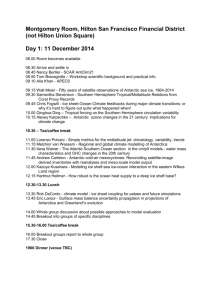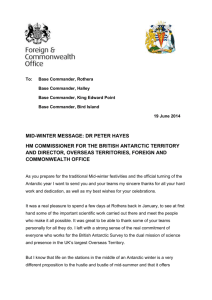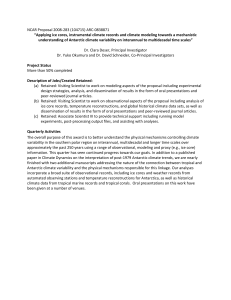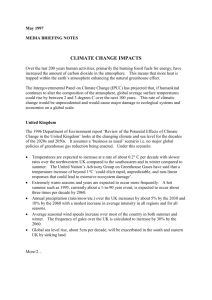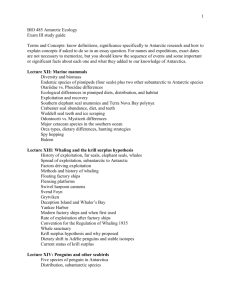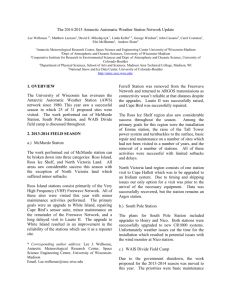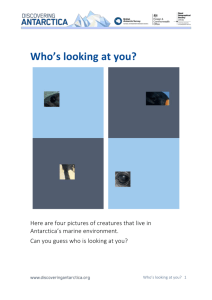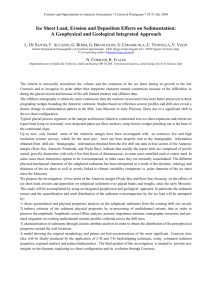costa-abstract - Byrd Polar and Climate Research Center
advertisement
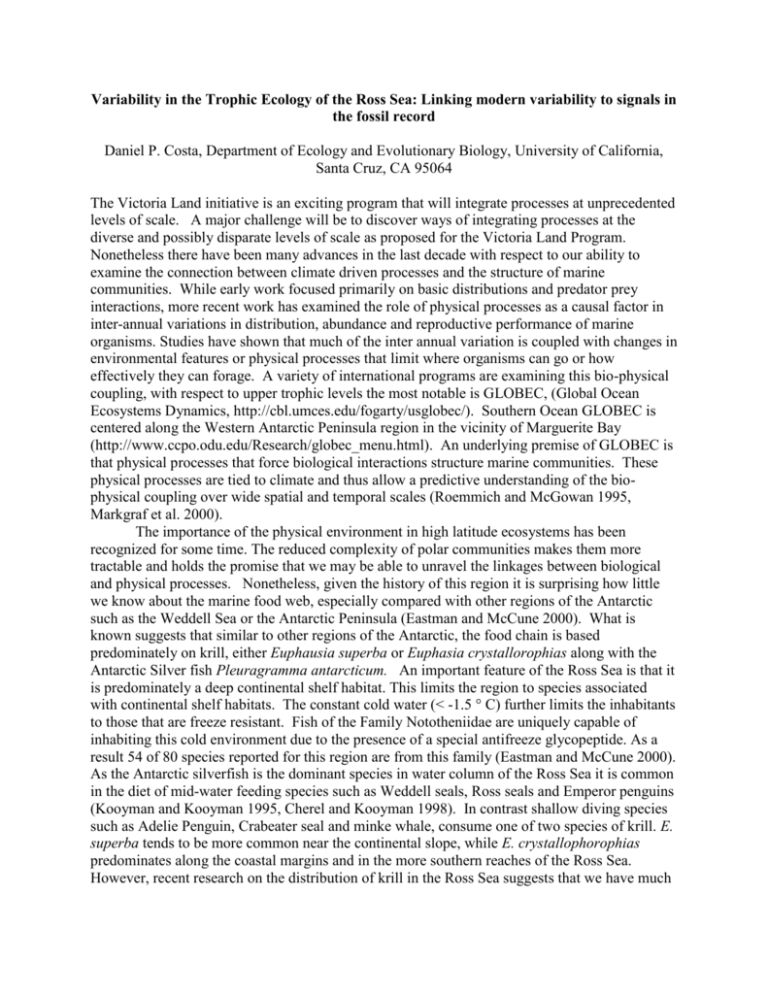
Variability in the Trophic Ecology of the Ross Sea: Linking modern variability to signals in the fossil record Daniel P. Costa, Department of Ecology and Evolutionary Biology, University of California, Santa Cruz, CA 95064 The Victoria Land initiative is an exciting program that will integrate processes at unprecedented levels of scale. A major challenge will be to discover ways of integrating processes at the diverse and possibly disparate levels of scale as proposed for the Victoria Land Program. Nonetheless there have been many advances in the last decade with respect to our ability to examine the connection between climate driven processes and the structure of marine communities. While early work focused primarily on basic distributions and predator prey interactions, more recent work has examined the role of physical processes as a causal factor in inter-annual variations in distribution, abundance and reproductive performance of marine organisms. Studies have shown that much of the inter annual variation is coupled with changes in environmental features or physical processes that limit where organisms can go or how effectively they can forage. A variety of international programs are examining this bio-physical coupling, with respect to upper trophic levels the most notable is GLOBEC, (Global Ocean Ecosystems Dynamics, http://cbl.umces.edu/fogarty/usglobec/). Southern Ocean GLOBEC is centered along the Western Antarctic Peninsula region in the vicinity of Marguerite Bay (http://www.ccpo.odu.edu/Research/globec_menu.html). An underlying premise of GLOBEC is that physical processes that force biological interactions structure marine communities. These physical processes are tied to climate and thus allow a predictive understanding of the biophysical coupling over wide spatial and temporal scales (Roemmich and McGowan 1995, Markgraf et al. 2000). The importance of the physical environment in high latitude ecosystems has been recognized for some time. The reduced complexity of polar communities makes them more tractable and holds the promise that we may be able to unravel the linkages between biological and physical processes. Nonetheless, given the history of this region it is surprising how little we know about the marine food web, especially compared with other regions of the Antarctic such as the Weddell Sea or the Antarctic Peninsula (Eastman and McCune 2000). What is known suggests that similar to other regions of the Antarctic, the food chain is based predominately on krill, either Euphausia superba or Euphasia crystallorophias along with the Antarctic Silver fish Pleuragramma antarcticum. An important feature of the Ross Sea is that it is predominately a deep continental shelf habitat. This limits the region to species associated with continental shelf habitats. The constant cold water (< -1.5 ° C) further limits the inhabitants to those that are freeze resistant. Fish of the Family Nototheniidae are uniquely capable of inhabiting this cold environment due to the presence of a special antifreeze glycopeptide. As a result 54 of 80 species reported for this region are from this family (Eastman and McCune 2000). As the Antarctic silverfish is the dominant species in water column of the Ross Sea it is common in the diet of mid-water feeding species such as Weddell seals, Ross seals and Emperor penguins (Kooyman and Kooyman 1995, Cherel and Kooyman 1998). In contrast shallow diving species such as Adelie Penguin, Crabeater seal and minke whale, consume one of two species of krill. E. superba tends to be more common near the continental slope, while E. crystallophorophias predominates along the coastal margins and in the more southern reaches of the Ross Sea. However, recent research on the distribution of krill in the Ross Sea suggests that we have much to learn as to the actual distribution let alone the factors responsible for it’s distribution (Azzali & Kalinowske 2000). While our understanding of krill dynamics in the Ross Sea is limited, we know that seasonal pack ice is essential for krill production. We know that E. superba grazes on under-ice algae in the winter and relies on the algae blooms associated with the spring melt and break up (Siegel and Loeb 1995). Krill abundance and recruitment is tightly correlated with the extent and timing of the seasonal pack ice, especially in the area of the Antarctic Peninsula (Loeb et al. 1997). The extent of the pack ice is related to a complex number of factors, but is correlated with average air temperature in the region. Variation in the extent of annual sea ice propagates in what is known as the Antarctic Circumpolar Wave (ACW). The ACW has a period of 4 yrs and a wavelength of 11,000 km and is influenced by the El Niño Southern Oscillation (White and Peterson 1996). Given the importance of sea ice to the prey of APEX predators it should not be surprising that variations in the abundance or reproductive success of APEX predators follows sea ice patterns (Fraser et a, 1992). For example, the recruitment or cohort strength of Antarctic pack ice seals shows considerable interannual variation that correlates with the ENSO index (Testa et al. 1991). More recently, Fraser et al. (1992) and Smith et al. (1999) have argued that changes in the penguin populations in the Antarctic Peninsula are associated with long-term changes in the persistence and extent of seasonal sea ice. Adelie penguins are at the northern limit of their range and in some locations overlap with Chinstrap penguins. During the winter Chinstrap penguins forage in open water, while Adelie penguins forage in the pack ice. In the Peninsula recent warming trends favor Chinstrap penguins. Whereas, in the Ross Sea where Adelie penguins are at the southern limit of their range, the warming trend appears to be causing an increase in their numbers. Considerable data exists to indicate strong associations between environmental variables (ice extent, wind stress, etc) and the Antarctic food web. However, the specific details of how these interactions occur are poorly understood. Fortunately, there are a variety of approaches that will allow us to examine these processes with respect to what drives these associations today as well to how they might have changed in the past. For example, the foraging behavior of seals, penguins and whales can be remotely tracked with specialized instrument that can record their diving behavior and location (Costa 1993, (Kooyman and Kooyman 1995). These data can be correlated with information on sea ice patterns (Watanuki et al. 1993), krill distribution (Croll et al. 1998) and reproductive performance (Kooyman 1993). Variation in the C and N isotopes of both modern and ancient organisms can provide insight into the diet or changes in diet that relate to the trophic level consumed (Rau et al. 1992). Changes in the distribution of abandoned ancient and modern Adelie penguin rookeries coupled with isotopes studies may provide insight into how conditions may have changed (Baroni and Orombelli 1994, Emslie et al. 1998). References: Baroni, C., and G. Orombelli. 1994. Abandoned Penguin Rookeries as Holocene Paleoclimatic Indicators in Antarctica. Geology V22:23-26. Cherel, Y., and G. L. Kooyman. 1998. Food of emperor penguins (Aptenodytes forsteri) in the western Ross Sea, Antarctica. Marine Biology (Berlin) 130:335-344. Costa, D. P. 1993. The secret life of marine mammals: Novel tools for studying their behavior and biology at sea. Oceanography 6:120-128. Croll, D. A., B. R. Tershy, R. P. Hewitt, D. A. Demer, P. C. Fiedler, S. E. Smith, W. Armstrong, P. J.M., T. Kiekhefer, V. R. Lopez, J. Urban, and D. Gendron. 1998. An integrated approach to the foraging ecology of marine birds and mammals. Deep-Sea Research. Eastman, J. T., and A. R. McCune. 2000. Fishes on the Antarctic continental shelf: Evolution of a marine species flock? Journal of Fish Biology 57:84-102. Emslie, S. D., W. Fraser, R. C. Smith, and W. Walker. 1998. Abandoned penguin colonies and environmental change in the Palmer Station area, Anvers Island, Antarctic Peninsula. Antarctic Science 10:257-268. Fraser, W. R., W. Z. Trivelpiece, D. G. Ainley, and S. G. Trivelpiece. 1992. Increases in Antarctic Penguin Populations - Reduced Competition with Whales or a Loss of Sea Ice Due to Environmental Warming. Polar Biology V11:525-531. Kooyman, G. L. 1993. Breeding Habitats of Emperor Penguins in the Western Ross Sea. Antarctic Science 5:143148. Kooyman, G. L., and T. G. Kooyman. 1995. Diving behavior or emperor penguins nurturing chicks at Coulman Island, Antarctica. Condor 97:536-549. Markgraf, V., T. R. Baumgartner, J. P. Bradubury, H. F. Diaz, R. B. Dunbar, B. H. Luckman, G. O. Seltzer, T. W. Swetnam, and R. Villalba. 2000. Paleoclimate reconstruction along the Pole-Equator-Pole transect of the Americas (PEP 1). Quarternary Sceince Reviews 19:125-140. Loeb, V., V. Siegel, O. Holm-Hansen, R. Hewitt, W. Fraser, W. Trivelpiece, and S. Trivelpiece. 1997. Effects of sea-ice extent and krill or salp dominance on the antarctic food web. Nature (London) 387:897-900. Rau, G. H., D. G. Ainley, J. L. Bengtson, J. J. Torres, and T. L. Hopkins. 1992. N-15/N-14 and C-13/C-12 in Weddell Sea Birds, Seals, and Fish - Implications for Diet and Trophic Structure. Marine Ecology-Progress Series V84:1-8. Roemmich, D., and J. McGowan. 1995. Climatic warming and the decline of zooplankton in the California current. Science 267:1324-1326. Siegel, V., and V. Loeb. 1995. Recruitment of Antarctic krill Euphausia superba and possible causes for its variability. Marine Ecology Progress Series 123:45-56. Smith, R. C., D. Ainley, K. Baker, E. Domack, S. Emslie, B. Fraser, J. Kennett, A. Leventer, E. Mosley-Thompson, S. Stammerjohn, and M. Vernet. 1999. Marine ecosystem sensitivity to climate change: Historical observations and paleoecological records reveal ecological transitions in the Antarctic Peninsula region. Bioscience 49:393-404. Testa, J. W., G. Oehlert, D. G. Ainley, J. L. Bengtson, D. B. Siniff, R. M. Laws, and D. Rounsevell. 1991. Temporal variability in Antarctic marine ecosystems: Periodic fluctuations in the phocid seals. Canadian Journal of Fisheries and Aquatic Sciences 48:631-639. Watanuki, Y., A. Kato, Y. Mori, and Y. Naito. 1993. Diving performance of adelie penguins in relation to food availability in fast sea-ice areas: comparison between years. Journal of Animal Ecology 62:634-646. White, W. B., and R. G. Peterson. 1996. An Antarctic Circumpolar Wave in Surface Pressure, Wind, Temperature and Sea-Ice Extent. Nature V380:699-702.

